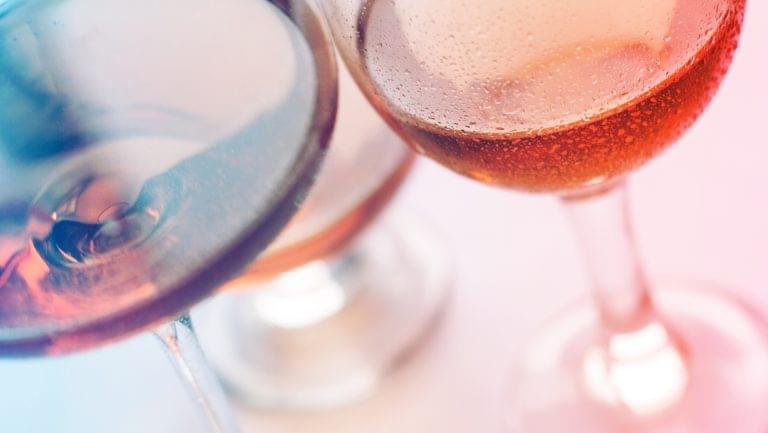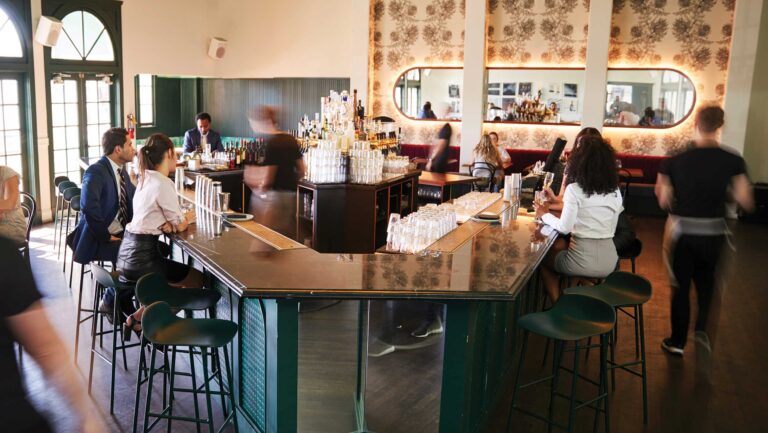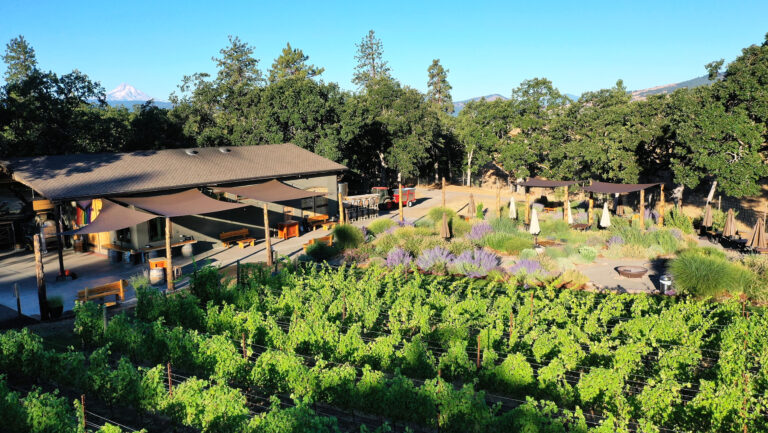Maybe it was all the chilled, light-bodied red wines that I’d seen my professional wine contemporaries chugging directly from bottles on Instagram, wine bars offering natural-style Gamays as chilled shots, and even my own consumption of colder reds these past few years, but wine service temperatures have been steadily creeping into my consciousness. Although some of this trend comes with a bit of iconoclasm, a lot of it is based in pleasure. Chill down a bright, juicy, low-tannin red wine like Beaujolais or a semi–whole cluster Loire Valley Cabernet Franc, and the vibrant fruit and floral notes seem to explode on the palate.
But back up for a minute: How did we get here? Some context is needed. A few years ago, while working as the wine director for Alain Ducasse’s Adour in Washington, D.C., sommelier Brent Kroll enforced a strict policy for all by-the-glass wines: Instead of reds grabbed off the back bar and whites snagged from a chilly refrigerator, all these bottles were pulled from the cellar when needed. Whites were never disguised with an arctic freeze, and reds had a refreshing chill. “We probably could’ve done a better job explaining our practices,” Kroll says. “But we just served it that way and didn’t say anything. Guests never complained, although staff was trained to explain our practices when prompted.”
Though Kroll’s approach was not widely emulated in other restaurants, his ideas are not new to the wine cognoscenti on all sides of the business. Winemaker Randall Graham of Bonny Doon Vineyards recounts, “I have forever been a proponent of appropriate serving temperatures for wine, which, as we both know, are generally significantly colder for reds and significantly warmer for whites than what one normally experiences in many restaurants.”

Don’t miss the latest drinks industry news and insights. Sign up for our award-winning newsletters and get insider intel, resources, and trends delivered to your inbox every week.
As Kroll recently launched his own Maxwell Park wine bar in D.C., he’s been thinking about how to go even further in serving wines at the ideal temperature, especially his robust selection of wines by the glass. “The back bar will have four waist-height coolers,” he says, which will be set at 44, 50, 55, and 60 degrees Fahrenheit. But Kroll’s most revolutionary move is on the menu: Each by-the-glass selection and bottle has a service temperature number printed next to it.
Why go this far? “I want to list them because I want it to become an industry standard to properly temperature-control everything, from bottles to by-the-glass,” he says. Now Kroll can hold himself accountable, while inspiring restaurants to take a hard look at their service standards. “I’ve noticed that even four-star and Michelin-star restaurants, a lot of them don’t temperature-control their by-the-glass [wines]. Whites are too cold and reds too warm.”
Meanwhile, at Pasquale Jones, a pizza restaurant in New York City, wine temperature was given priority in the restaurant’s design, according to partners Robert Bohr and Grant Reynolds. “The only thing that’s lower than wine storage when designing a restaurant is coat check,” lamented Bohr, as we talked during a Wednesday dinner rush.
In Pasquale Jones’s basement cellar, wines are stored according to their desired serving temperatures. Red wines are located in a 20-foot-long room, with heavier-bodied selections on one end, and medium- to light-bodied reds near a door to a cooler space for whites. Since cool air leaks out from the whites storage as bottles are retrieved, there’s a perceptible temperature gradient as you walk through the space. Up on the restaurant floor, a similar approach to that of Maxwell Park is employed, with lowboys and EuroCave wine refrigerators set to specific temperatures.
As far as the serving temperatures Reynolds wants at Pasquale Jones, some are warmer than you might expect, while others are colder. Pulling a bottle from a EuroCave set at 50 degrees Fahrenheit, Reynolds says, “I like these younger, primary stainless-steel, aged Syrahs from the Northern Rhône colder.” He says he finds that the wine’s youthful intensity is improved by a lower temperature. Conversely, wines that show more secondary flavors and aromas, like aged Nebbiolo, are pulled from storage at a more traditional 58 degrees Fahrenheit. In the warm summer months, all storage is dialed down a few degrees cooler to give a boost of refreshment.
I notice Dom Perignon Champagne in a 45-degree Fahrenheit area—warmer than the typical serving temperature—and I’m obliged to ask, Do clients push back on temperature? “Even if you’re not really that into wine,” Reynolds says, “people get that having sparkling wine at a cool [not freezing] temperature is a better experience.”
Most of all, though, it’s Pasquale Jones’s forward-thinking design regarding bottle temperature maintenance during service that catches my attention. Sleek metal vents snake across credenzas around the dining room—including several vents on a central island that also acts as a maître d’ stand—where bottles sit on perforated shelves above beds of ice. This arrangement keeps cold air cycling around the bottles so they don’t need to be shoved into ice buckets.
As my clam, parsley, and rapini pizza arrived from Pasquale Jones’s sizzling oven, Reynolds poured me 2013 Guido Marsalane Fiano di Avellino—a leesy, woolly, lemon-tinged wine from Campania, Italy. Not only was the temperature (around 45 degrees by my estimate, warmer than the default white wine fridge) pleasurable, but the differential in temperature between the wine and pizza didn’t clash. Says Reynolds, “You would never pour cold sauce onto a hot protein, would you?”
Master Sommelier Larry Stone points out that this attention to wine temperature isn’t new. “I always told staff at Charlie Trotter’s, Rubicon, and before that at Four Seasons, about the importance of not having wine too cold or too hot, and varying it for the dish and the wine involved.”
Still, Stone finds that wine serving temperatures overall have gone down since his days on the floor. He sees drinkers’ emphasis on freshness as the main reason for the change. This trend stands in contrast to an earlier era, when riper wines were more in vogue, and a warmer bottle of red wine elevated its sweetness and richness.
At Montreal’s Joe Beef, the trend toward cooler reds is on full display. Cofounder Dave McMillan and the restaurant’s wine director, Vanya Filipovic (who is also a partner with McMillan at the wine bar Vin Papillon), have always stored and served red wines cooler, from cool-cellar to refrigerator-cold temperatures.
“I like reds to be a couple degrees colder than ‘normal,’” McMillan explains, noting that because ambient warming occurs when a glass arrives and sits on a table it’s ideal to pour a few degrees below the desired sipping temperature. “I feel cooler reds are more refreshing as you eat hot food,” McMillan says. “Plus, I drink more wine when it’s crisp, and less as it warms, so the restaurateur in me equates this to more wine sales.” I couldn’t argue after dining at McMillan’s third restaurant, Liverpool House. The dark, juicy, and slightly dusty cocoa notes of the pipeño style Pais-Carignan blend from Chile’s Viña Maitia, pulled directly from the lowboy behind the bar, brightened and heightened every bite of my foie gras–bathed chicken studded with truffle.
Back in Washington, D.C., Kroll hopes that the practice of listing wine temperatures at Maxwell Park will stake his philosophical claim while also nudging his contemporaries to think more about serving temperatures. Moreover, he sees it as a chance to empower his guests. “Listing our ideas about optimal serving temperature is setting the table for a conversation,” he says, noting that well-informed guests can only help move the discussion about wine temperatures forward.

Dispatch
Sign up for our award-winning newsletter
Don’t miss the latest drinks industry news and insights—delivered to your inbox every week.
Peter Weltman is a sommelier and entrepreneur based in San Francisco who explores native grapes from ancient sources. He writes for global food publications, gives speeches on wine activism, and creates immersive experiences about his movement, Borderless Wine. Find out where he’s reporting from next on Instagram.







